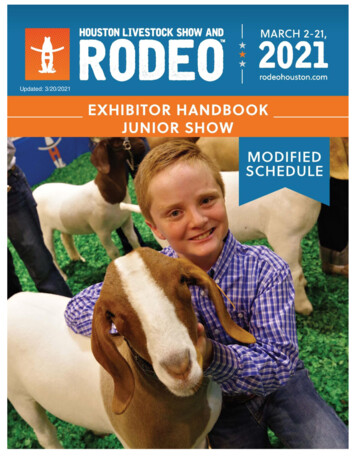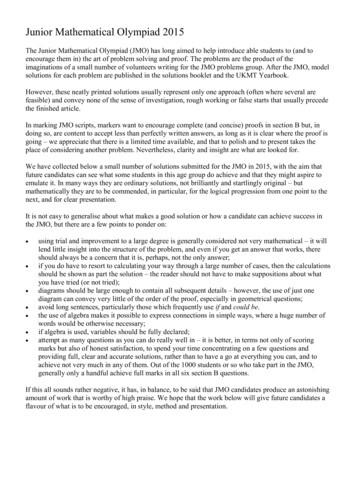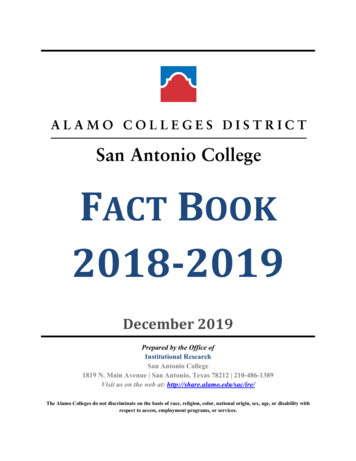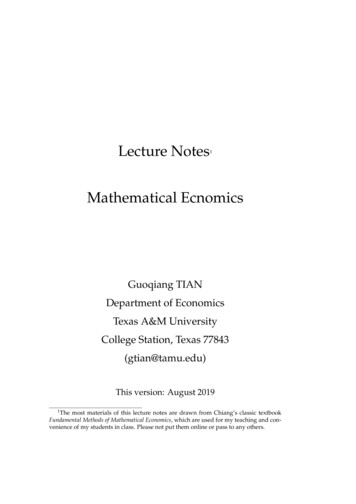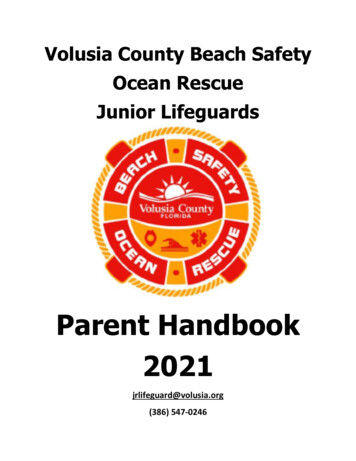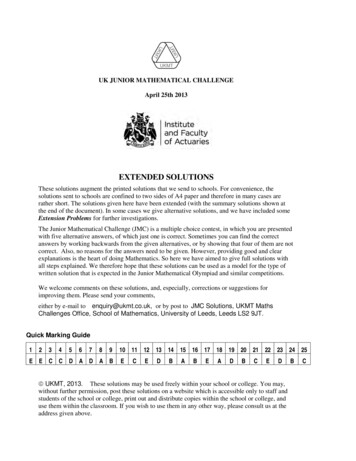
Transcription
UK JUNIOR MATHEMATICAL CHALLENGEApril 25th 2013EXTENDED SOLUTIONSThese solutions augment the printed solutions that we send to schools. For convenience, thesolutions sent to schools are confined to two sides of A4 paper and therefore in many cases arerather short. The solutions given here have been extended (with the summary solutions shown atthe end of the document). In some cases we give alternative solutions, and we have included someExtension Problems for further investigations.The Junior Mathematical Challenge (JMC) is a multiple choice contest, in which you are presentedwith five alternative answers, of which just one is correct. Sometimes you can find the correctanswers by working backwards from the given alternatives, or by showing that four of them are notcorrect. Also, no reasons for the answers need to be given. However, providing good and clearexplanations is the heart of doing Mathematics. So here we have aimed to give full solutions withall steps explained. We therefore hope that these solutions can be used as a model for the type ofwritten solution that is expected in the Junior Mathematical Olympiad and similar competitions.We welcome comments on these solutions, and, especially, corrections or suggestions forimproving them. Please send your comments,either by e-mail to enquiry@ukmt.co.uk, or by post to JMC Solutions, UKMT MathsChallenges Office, School of Mathematics, University of Leeds, Leeds LS2 9JT.Quick Marking Guide123456789E E C C D A D A B10 11 12 13 14 15 16 17 18 19 20 21 22 23 24 25ECEDBABEADBCED UKMT, 2013. These solutions may be used freely within your school or college. You may,without further permission, post these solutions on a website which is accessible only to staff andstudents of the school or college, print out and distribute copies within the school or college, anduse them within the classroom. If you wish to use them in any other way, please consult us at theaddress given above.BC
1.Which of the following has the largest value?A1 0.1B 1 0.01C 1 0.001D 1 0.0001E 1 0.00001Solution: EIn each case a number is subtracted from 1. The smaller the number we subtract, the larger theanswer will be. So the largest value is obtained when the smallest number is subtracted.2.Heidi is 2.1 m tall, while Lola is only 1.4 m tall. What is their average height?A 1.525 mB 1.6 mC 1.7 mD 1.725 mE 1.75 mSolution: ETheir average height, in metres, is3.2.1 1.4 3.5 1.75 .22What is the value of x?xoA 25B 35C 40D 65E 155650Solution: Coxo wLet the other angles be as marked in the diagram. Then y 65 aszothe angles marked 65o and yo are the base angles of an isoscelestriangle. Because the angles in a triangle sum to 180o,z 180 65 65 50 . Now, w z , as the angles marked wo and zoare vertically opposite. Therefore w 50 . So, the angle markedxo is the third angle of a triangle in which the other two angles are 50o and 90o. Thereforex 180 50 90 40 .yo650Extension Problem3.1In the diagram alongside, the angle that was previouslylabelled 65o is now labelled ao. Find a formula for x interms of a. Check that your formula gives the same answerin the case that a 65 as you gave to Question 3.xoao3.2Is there a maximum value that a can have?
4.Gill went for a five-hour walk. Her average speed was between 3 km/h and 4 km/h.Which of the following could be the distance she walked?A 12 kmB 14 kmC 19 kmD 24 kmE 35 kmSolution: CWalking at 3km/h for five hours, Gill would walk 5 3 km 15 km , and at 4km/h she would walk5 4 km 20 km . As her average speed is between 3 km/h and 4 km/h, she walks between 15 kmand 20km. Of the options given, only 19 km is in this range.5.The diagram shows a weaver’s design for a rihlèlò, a winnowing trayfrom Mozambique.How many lines of symmetry does the design have?A 0B 1C 2D 4E 8Solution: DThe four lines of symmetry are shown in the diagram.6.What is the value of ((1 1) 1) ((1 (1 1) ) ?A 2B 1C 0D 1E 2Solution: AWe have ((1 1) 1) ((1 (1 1) ) (0 1) (1 0) ( 1) (1) 2 .Extension Problem6.1The answer to Question 6 shows that by putting brackets in the appropriate places in1 1 1 1 1 1 1 1we obtain an expression whose value is 2. How many different values can be obtained byinserting brackets in different ways?7.After tennis training, Andy collects twice as many balls as Roger and five more thanMaria. They collect 35 balls in total. How many balls does Andy collect?A 20B 19C 18D 16E 8
Solution: DSuppose that Andy collects x balls. Since Andy collects twice as many balls as Roger, Rogercollects 12 x balls. Andy collects five more balls than Maria. So Maria collects x 5 balls. Sobetween them, Andy, Roger and Maria collect x 12 x ( x 5) balls. They collect 35 balls in total.Thereforex 12 x ( x 5) 35 .Multiplying this equation by 2 gives2 x x 2 x 10 70 .This is equivalent to5 x 80 .It follows that x 16 .Note: As we are asked for the number of balls that Andy collects, it is natural to begin the problemby letting x be this number. However, we see then see that this leads to an equation which includesa fraction. If you look ahead, you might prefer to let the number of balls that Roger collects be x.Then Andy collects 2 x balls and Maria collects 2 x 5 balls. We then obtain the equation2 x x (2 x 5) 35with no fractions in it. This equation is equivalent to 5 x 40 , from which we deduce that x 8 .This calculation is easier that the one we gave above, but, if you use this method, you need toremember that the answer we are asked for is 2 x and not just x.8.Two identical rulers are placed together, as shown (not to scale).Solution:EachA ruler is exactly 10 cm long and is marked in centimetres from 0 to 10. The 3 cmmarkon each ofrulerwith thethe 44 cmcm marksmark onThe lengthL consiststheis1 alignedcm betweenonthetheother.two rulers, together with thelengths between the 4 cm marks and the ends of the ruler, which is 6 cm in each case. So the lengthis 6 cm 1 cm 6cm, that is, 13 cm. Hence L 13 .L cmThe overall length is L cm. What is the value of L?A 13B 14C 15D 16E 17Solution: AThe distance between the 4 cm mark and the 10 cm mark at the end of the ruler is(10 4)cm 6 cm . The overall length is made up of the length on each ruler from the 4cm mark tothe 10 cm mark, plus the length from the 3 cm mark to the 4 cm mark. This latter distance is 1 cm.So, L 6 6 1 13 .9.Peter has three times as many sisters as brothers. His sister Louise has twice as manysisters as brothers. How many children are there in the family?A 15B 13C 11D 9E 5
Solution: BSuppose Peter has b brothers and hence 3b sisters. So, including Peter, there are b 1 boys and 3bgirls in the family. So Louise has b 1 brothers and 3b 1 sisters. Since Louise has twice as manysisters as brothers, 3b 1 2(b 1) . This equation is equivalent to 3b 1 2b 2 . So b 3 andthere are 4 boys and 9 girls in the family, making 13 children altogether.10.On standard dice the total number of pips on each pair of opposite faces is 7.Two standard dice are placed in a stack, as shown, so that the total number ofpips on the two touching faces is 5.What is the total number of pips on the top and bottom faces of the stack?A 5B 6C 7D 8E 9Solution: EThe total number of pips on the top and bottom faces of the two dice is 7 7 14 . As there is atotal number of 5 pips on the touching faces, there are 14 5 9 pips altogether on the top andbottom faces of the stack.11.Usain runs twice as fast as his mum. His mum runs five times as fast as his pet tortoise,Turbo. They all set off together for a run down the same straight path. When Usain hasrun 100 m, how far apart are his mum and Turbo the tortoise?A 5mB 10 mC 40 mD 50 mE 55 mSolution: CWhen Usain has run 100m his mum has run half this distance, that is, 50 m and Turbo has run onefifth of his mum’s distance, that is, 10 m. So the distance between his mum and Turbo is(50 10) m 40 m.
12.How many hexagons are there in the diagram?A 4B 6C 8D 10E 12Solution: EThe twelve different hexagons are shown shaded in the diagram below.Extension Problems12.1 Are there any triangles in the diagram of Question 12?12.2 How many quadrilaterals are there in this diagram?12.3 How many pentagons are there in this diagram?12.4 For which values of n can you find at least one polygon with n sides in this diagram?13.When painting the lounge, I used half of a 3 litre can to complete the first coat of paint.I then used two thirds of what was left to complete the second coat. How much paintwas left after both coats were complete?A 150 mlB 200 mlC 250 mlD 500 mlE 600 mlSolution: DThe first coat uses half the paint, so half remains. Two thirds of this is then used so one third of onehalf, that is one sixth remains. So the volume remaining is 16 3 litres. So there remains 0.5 litres,that is, 500 ml of paint.
14.Each side of an isosceles triangle is a whole number of centimetres. Its perimeter haslength 20 cm. How many possibilities are there for the lengths of its sides?A 3B 4C 5D 6E 7Solution: BLet the length of the two equal sides of the isosceles triangle be a cm. Since the triangle hasperimeter 20 cm, the third side will have length 20 2a cm. Since this must be a positive length,20 2a 0 and so a 10 . In a triangle the length of one side must be less than the sum of thelengths of the other two sides. So 20 2a 2a . This gives 20 4a and hence 5 a . So, we have5 a 10 . Therefore, as a is a whole number, there are just four possible values for a, namely 6,7, 8 and 9. So there are four possibilities for the side lengths of the triangle,6, 6, 8; 7, 7, 6; 8, 8, 4 and 9, 9, 2.Extension Problems14.1 How many different possibilities are there for the side lengths of an isosceles triangle each ofwhose sides is a whole number of centimetres and whose perimeter is 24 cm?14.2 Can you find a formula for the number of different isosceles triangles each of whose sides isa whole number of centimeters and whose perimeter has length n centimeters, where n is apositive integer with n 3 ?We now consider the analogous problem for triangles which are not necessarily isosceles.14.3 For each whole number n, with 3 n 10 , find the number of different triangles whose sidelengths are all a whole number of centimetres and whose perimeter is n cm.14.2 Can you find a formula for the number of different triangles each of whose sides is a wholenumber of centimeters and whose perimeter has length n centimeters, where n is a positiveinteger with n 3 ?15.The Grand Old Duke of York had 10 000 men. He lost 10% of them on the way to thetop of the hill, and he lost 15% of the rest as he marched them back down the hill. Whatpercentage of the 10 000 men were still there when they reached the bottom of the hill?A 76 12 %B 75%C 73 12 %D 66 23 %E 25%Solution: AAfter losing 10% of the men, the Grand Old Duke of York was left with 90% of them. After losing85 9015% of these, he was left with 85% of the remaining 90% men. So he is left with 100 100765076.5 of the men he started, that is, 76 12 % of the original number of men.10000100
16.Ulysses, Kim, Mei and Tanika have their 12th, 14th, 15th and 15th birthdays today. Inwhat year will their ages first total 100?A 2023B 2024C 2025D 2057E 2113Solution: BToday the total of their ages is 12 14 15 15 56 . Each year they are all grow 1 year older, andso the total of their ages increases by 4. This needs to increase by 100 56 44 years in order to44 11 years. In 11 years time it will be 2013 11 2024 .reach 100 years. This will take417.A 5 cm 5 cm square is cut into five pieces, as shown.CEach cut is a sequence of identical copies of the same shape butpointing up, down, left or right.D EWhich piece has the longest perimeter?ABCBDAESolution: EWe let the length of the shape be x cm. Since this shape is longer than the side length of one ofthe squares, 1 x . The perimeters of the five pieces are, in centimetres, A 4 6 x , B 2 10 x ,C 7 5 x , D 6 6 x and E 1 11x , respectively. As 1 x , E has the longest perimeter.18.Weighing the baby at the clinic was a problem. The baby would not keep still andcaused the scales to wobble. So I held the baby and stood on the scales while the nurseread off 78 kg. Then the nurse held the baby while I read off 69 kg. Finally I held thenurse while the baby read off 137 kg. What was the combined weight of all three ?A 142 kgB 147 kgC 206 kgD 215 kgE 284 kg(This problem appeared in the first Schools' Mathematical Challenge in 1988 – 25 years ago.)Solution: AWe let the weights of the baby, the nurse and myself be x kg, y kg and z kg, respectively. Theinformation we are given implies that x z 78 , x y 69 and y z 137 . Adding these threeequations gives ( x z ) ( x y ) ( y z ) 78 69 137 , that is, 2 x 2 y 2 z 284 . It followsthat x y z 142 . So the combined weight of all three was 142 kg.Extension Problem18.1 What were the individual weights of the baby, the nurse and me?
19.A swimming club has three categories of members: junior, senior, veteran. The ratio ofjunior to senior members is 3:2 and the ratio of senior members to veterans is 5:2 .Which of the following could be the total number of members in the swimming club?A 30B 35C 48D 58E 60Solution: DSuppose that there are x junior members. Then, as the ratio of junior to senior members is 3:2,there are 23 x senior members. Hence, as the ratio of senior members to veterans is 5:2, there are2529( 23 x) 154 x veterans. Therefore, the total number of members is x 23 x 154 x 15x . For this to29be an integer, x must be a multiple of 15. It follows that 15x is a multiple of 29. Of the givenoptions, only 58 is a multiple of 29. [This corresponds to taking x 30 . In this case there are 30juniors, 20 seniors and 8 veterans in the club.]Note: This is another problem where fractions can be avoided by thinking ahead. You may noticethat the number of senior members must be a multiple of 2 and of 5. So this number must be amultiple of 10. So let 10x be the number of senior members. In then follows that there are 15xjunior members and 4x veterans. So there are 29x members altogether. It follows that the number ofmembers is a multiple of 29.20.A ‘long knight’ moves on a square grid. A single move, as shown,consists of moving three squares in one direction (horizontally orvertically) and then one square at right angles to the first direction.What is the smallest number of moves a long knight requires to gofrom one corner of an 8 8 square board to the diagonally oppositecorner?A 4B 5C 6D 7E 8Solution: BMethod 1: Our first method is systematic but long n the left hand diagram we have put 0 in the square where the long knight starts and 1s in thesquares which the long knight can reach in 1 move. In the middle diagram we have put a 2 in allthe squares, other than that already marked 0, that the long knight can reach in one move from thesquares marked 1. The nine squares marked with a 2 in this diagram are all the squares that thelong knight can reach in two moves.13343Next we put a 3 in all the squares, other than those already marked, which the long knight canreach in one move from the squares marked with a 2, and so on. The completed diagram is shown
on the right. The number in a square indicates the smallest number of moves it takes the longknight to reach that square. We see from this that it takes the long knight five moves to reach thecorner which is diagonally opposite the square where it started.Method 2: We note that to get from the bottom left-hand corner to the top right-hand corner thelong knight must end up 7 squares up and 7 squares right from its original position, a total of 14squares. In any one move, it goes at most 3 squares up and 1 squares to the right, or at most 1square up and 3 squares to the right, in each case a total of 4 squares.So after 3 or fewer moves it cannot end up in the top right-handsquare. In 4 moves the number of squares it will have movedupwards must be even, as it will be the sum of four odd numbers,and so cannot be the required 7 squares to reach the top right-handcorner. Therefore at least 5 moves are needed. The diagram showsone way in which the task may be achieved in 5 moves.Extension Problems20.1 In how many different ways can the long knight get from the bottom left-hand corner to thetop right-hand corner in 5 moves?20.2 A knight’s tour on a chessboard is a sequence of 64 movesby a chess knight on an 8 8 grid in which it ends up on thesquare where it begins, and visits each of the other squaresexactly once. An example of a knight’s tour is shown on theright. This knight’s tour was found by the great Swissmathematician Leonhard Euler (1707-1783).It is not possible to find a complete long knight’s tour of achessboard because, as we have seen in the solution toQuestion 20, a long knight starting on a particular squarecannot reach half of the squares on the chessboard. If it startson a white square it can only reach the other white squares,and if it starts on a black square it can only reach the otherblack squares.Can you find a long knight’s tour of the black squares, that is,a sequence of 32 moves by a long knight, starting on a blacksquare, ending up on the square where it begins, and visitingeach of the other black squares exactly once?21.The 5 4 grid is divided into blocks. Each block is a squareor a rectangle and contains the number of cells indicated bythe integer within it.Which integer will be in the same block as the shaded cell?A 2B 3C 4D 5E 654
263Solution: CThe 5 must be in a 5 1 block, and this can only be made up of the toprow of the grid. There is not room in the grid for a 6 1 block, so the 6must be in a 3 2 block. There are only two possibilities for a 3 2block which does not include any of the other numbers and which doesnot overlap the 5 1 block. These are shown in the two diagrams on theright.If the 3 2 block is arranged as in the top diagram, the 3 must be in the3 1 block shown. But then there is not space to put the 4 in a block offour squares. Therefore the 3 2 block must be as in the lower diagramThen the 4 must be in a 2 2 block and the diagram may be completedas shown.5426354263We therefore see that the shaded square must be in the same block asthe 4.22.Two numbers in the 4 4 grid can be swapped to create a MagicSquare (in which all rows, all columns and both main diagonals addto the same total).9 6 3 164 13 10 514 1 8 117 12 15 2What is the sum of these two numbers?A 12B 15C 22D 26E 28Solution: EWe have included, in italics, the row and column totals. The circled numbersare the totals of the numbers in the two main diagonals.The sum of all the numbers in the square is 1 2 . 15 16 .This is the16th triangular number, 12 (16 17) 136 . So the total of each row,column and main diagonal should be 14 (136) 34 .9 6 3 16 344 13 10 5 3214 1 8 11 347 12 15 2 3634 34 32 36 34 32We thus see that we need to increase the totals of row 2 and column 2by 2, and decrease the totals of row 4 and column 3 by 2. Clearly, the only way to achieve this byswapping just two numbers is to swap 13, in row 2 and column 2, with 15 in row 4 and column 3.When we swap 13 and 15 the total on the main diagonal from top left to bottom right is increasedby 2 to 34, while the total on the other main diagonal is unchanged. So by swapping 13 and 15 wecreate a magic square. 13 15 28 . The discussion above makes it clear that this is the only swapthat makes the total of each row and column, and the main diagonals, equal to 34.
23.In our school netball league a team gains a certain whole number of points if it wins agame, a lower whole number of points if it draws a game and no points if it loses agame. After 10 games my team has won 7 games, drawn 3 and gained 44 points. Mysister's team has won 5 games, drawn 2 and lost 3. How many points has her teamgained?A 28B 29C 30D 31E 32Solution: DSuppose that there are w points for a win, and d points for a draw. Since my team gains 44 pointsfrom 7 wins and 3 draws, 7 w 3d 44 . Here w and d are positive integers with w d . Since7 w 44 , we have 1 w 6 . Since 3d 44 7 w , 44 7 w must be a multiple of 3. The onlywhole numbers in the range 1 w 6 , for which 44 7 w is a multiple of 3, are w 2 and w 5 .When w 2 , 3d 44 7 w 30 , giving d 10 , contradicting w d . When w 5 ,3d 44 7 w 9 , giving d 3 . In this case w d . So w 5 and d 3 . Therefore, my sister’steam with 5 wins and 2 draws has gained 5 5 2 3 31 points.24.Three congruent squares overlap as shown. The area of the threeoverlapping sections are 2 cm2, 5 cm2 and 8 cm2 respectively. Thetotal area of the non-overlapping parts of the square is 117 cm2.What is the side-length of each square?A 6 cmB 7 cmE 8cmD 9cmE 10 cmSolution: BThe total area of the three squares is the sum of area of the non-overlapping parts and twice theareas of the overlapping sections as each of these forms part of two squares. So the total area of thesquares is, in cm2, 117 2 (2 5 8) 117 2 15 117 30 147 . Hence the area of one of thesquares is one third of this, that is, 49 cm2. Therefore the side-length of each square is 7 cm.25.For Beatrix's latest art installation, she has fixed a 2 2 square sheetof steel to a wall. She has two 1 2 magnetic tiles, both of which sheattaches to the steel sheet, in any orientation, so that none of the sheetis visible and the line separating the two tiles cannot be seen. Asshown alongside, one tile has one black cell and one grey cell; theother tile has one black cell and one spotted cell.How many different looking 2 2 installations can Beatrix obtain?A 4B 8C 12D 14E 24Solution: CIn the 2 2 square sheet, there are 4 positions in which Beatrix could place the spotted cell. Foreach position of the spotted cell, there remain 3 positions where she could place the grey cell. Onceshe has placed these, she has no choice for the two black cells. Hence there are 4 3 12 possibleinstallations. It can be checked that Beatrix can make each of these installations by positioning thetwo tiles appropriately. [She can create each of the installations in which the black squares occupythe diagonal positions in two ways, and all the other installations in just one way.] So Beatrix cancreate 12 differently looking installations.
21.22.CEAs 5 is a prime number, it must lie in a 5 1 rectangle. So5the only possibility is the rectangle which covers the top row4of the grid. Now consider 6: there is insufficient room for a266 1 rectangle so it must lie in a 3 2 rectangle. There are3only two such rectangles which include 6 but do notinclude either 4 or 3. If 6 comes in the middle of the top row of a 2 3rectangle then there is space for a 3 1 rectangle including 3. But then there isnot enough space for a rectangle including 4. So 6 must be placed in therectangle shown. There is now insufficient room to place 4 in a 4 1 rectangleso it must lie in the 2 2 square shown, which includes the shaded square. Thisleaves the grid to be completed as shown.The diagram shows the totals of the rows and columns. The9 6 3 16 34circled numbers are the total of the numbers in the two main4 13 10 5 32diagonals. Note, by considering the average values of the14 1 8 11 34rows and columns, that each should total 34. Row 2 and7 12 15 2 36column 2 are both 2 short. So their common entry, 13, needs 34 34 32 36 34 32to increase by 2. So 13 must be interchanged with 15. (Thischange also reduces row 4 and column 3 by 2 and increases the main diagonalby 2, thus making all the sums equal 34 as desired.) So the sum of the numbersto be swapped is 28.23.DLet the points awarded for a win and a draw be w and d respectively. Then7w 3d 44. The only positive integer solutions of this equation are w 2,d 10 and w 5, d 3. However, more points are awarded for a win thanfor a draw so we deduce that 5 points are awarded for a win and 3 points for adraw. So the number of points gained by my sister's team is 5 5 2 3 31.24.BEach of the overlapping areas contributes to the area of exactly two squares. Sothe total area of the three squares is equal to the area of the non-overlappingparts of the squares plus twice the total of the three overlapping areas i.e.(117 2 (2 5 8)) cm2 (117 30) cm2 147 cm2.So the area of each square is (147 3) cm2 49 cm2. Therefore the length ofthe side of each square is 7 cm.25.CBy arranging the tiles in suitable positions it is possible to place the 1 1spotted square in any one of four corners of the steel sheet and then to place thegrey square in any one of the other three corners. The other two corners will thenbe occupied by black squares. So, in total, there are 4 3 12 differentlooking installations.)UK JUNIOR MATHEMATICAL CHALLENGETHURSDAY 25th APRIL 2013Organised by the United Kingdom Mathematics Trustfrom the School of Mathematics, University of Leedshttp://www.ukmt.org.ukSOLUTIONS LEAFLETThis solutions leaflet for the JMC is sent in the hope that it mightprovide all concerned with some alternative solutions to the onesthey have obtained. It is not intended to be definitive. Theorganisers would be very pleased to receive alternatives createdby candidates.The UKMT is a registered charity
1.EAll of the alternatives involve subtracting a number from 1. The largest result,therefore, will correspond to the smallest number to be subtracted, i.e. 0.00001.2.ETheir average height isCTriangle BCD is isosceles, so BCD BDC 65 .The sum of the interior angles of a triangle is 180 so CBD (180 2 65) 50 .Therefore ABE 50 (vertically opposite angles). So AEB (180 90 50) 40 .3.2.1 1.4m 1.75 m.2x DThe diagram shows the four lines of symmetry.DBLet the two equal sides of the isosceles triangle have length a and the other sidehave length b. Then 2a b 20. Since the sum of the lengths of any twosides of a triangle is greater than the length of the third, 2a b. Hence4a 2a b. So 4a 20, i.e. a 5. Also a 10 since 2a b 20. Sothe possibilities are a 6, b 8; a 7, b 6; a 8, b 4; and a 9, b 2.15.AWhen he starts to come down the hill, the Grand Old Duke of York has 90% ofhis men left. He loses 15% of these, so at the bottom of the hill he has 85% of85190% of the original number left. As 90 76 , this means that 76 12 % of1002his men were still there when they reached the bottom of the hill.16.BThe sum of the ages of the four children is 12 14 15 15 56. Eachyear on their birthday, this sum increases by 4. So the number of years beforethe sum reaches 100 is (100 56) 4 11. Therefore their ages will firsttotal 100 in 2024.17.ELet x cm be the length of theshape. Although x is not given, it is clear thatx 1. The lengths, in cm, of the perimeters of pieces A, B, C, D, E are 4 6x,2 10x, 7 5x, 6 6x, 1 11x respectively. As 4 6x 6 6x, the piecewith the longest perimeter is B, C, D or E. As x 1, it may be deduced that7 5x 6 6x 2 10x 1 11x, so E has the longest perimeter.18.ALet the weights, in kg, of baby, nurse and me be x, y, z respectively. Thenx z 78; x y 69; y z 137. Adding all three equations gives2x 2y 2z 284, so x y z 284 2 142.(To find the combined weight, it is not necessary to find the individual weights,but baby weighs 5kg, nurse weighs 64 kg and I weigh 73 kg.)19.DFor every 2 senior members in the swimming club there are 3 junior members.For every 5 senior members there are 2 veteran members. The lowest commonmultiple of 2 and 5 is 10, so it may be deduced that the number of senior membersis a multiple of 10. For every 10 senior members in the swimming club there are15 junior members and 4 veteran members. So the total number of members is amultiple of 29. Of the alternatives given, the only multiple of 29 is 58.20.BThe ‘long knight’ needs to move exactly seven squares to theright and exactly seven squares upwards. Although it is possibleto move seven squares to the right in three moves (1, 3 and 3), indoing so it could move upwards by a maximum of five squares(3, 1 and 1). Similarly, it could move seven squares upwards inthree moves, but could then move a maximum of five squares tothe right. In four moves, the number of squares moved to theright must be even, since it is the sum of four odd numbers. So at least five moves arerequired and the diagram shows one way in which the task may be achieved in five moves.65 D5.7.14.CBDistance travelled average speed time of travel, so Gill travelled between15 km and 20 km. Of the alternatives given, only 19 km lies in this interval.((1After the first coat, half of the paint is left. So after the second coat, the volumeof paint remaining is one third of half of the capacity of the tin, i.e. one sixth ofthree litres 500 ml.ECADA4.6.13. 1) 1) (1 (1 1)) (0 1) (1 0) 1 1 2.Let the number of balls collected by Roger be x. Then Andy collects 2x balls andMaria collects (2x 5) balls. So x 2x 2x 5 35, i.e. 5x 40, i.e. x 8.So Andy collected 16 balls.8.AThe number 3 on the top ruler (which is 7cm from the left-hand end) aligns withthe 4 on the bottom one (which is 6cm from the right-hand end). ThusL 7 6 13.9.BLet there be b boys and g girls in the family. Then Peter has g sisters and(b 1) brothers. So g 3 (b 1). Louise has (g 1) sisters and b brothers.So g 1 2b. Therefore 2b 1 3b 3, i.e. b 4. So g 9.Therefore there are 4 boys and 9 girls in the family, i.e. 13 children in total.10.EThe top and bottom faces of the stack and the two touching faces form two pairsof opposite faces.So the total number of pips on these four faces is 2 7 14. T
Suppose Peter has b brothers and hence 3b sisters. So, including Peter, there are . b 1boys and 3. b. girls in the family. So Louise has . b 1brothers and . b. 3 1 sisters. Since Louise has twice as many sisters as brothers, b b. 3 1 2( 1) . This equation is equivalent to. b b. 3 1 2 2 . So . b 3and
